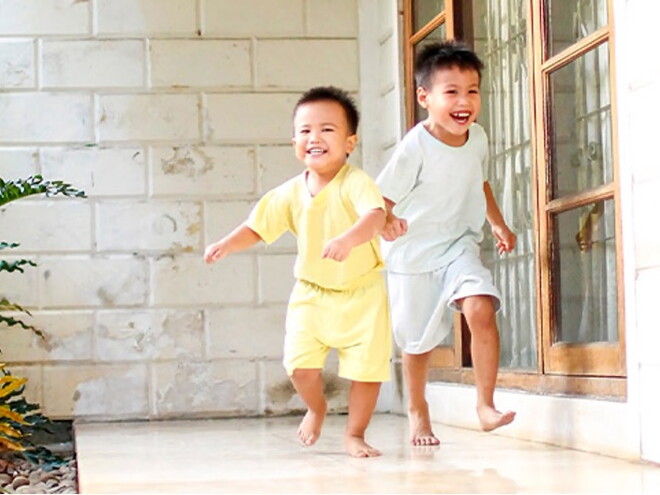
Pasaway Na Ba? Don't Worry, Mommy, It's Not A Sign Of Aggression
Does your child love jumping on couches and tumbling onto the floor? How about running around the house or wrestling with his siblings? Do you often see him climbing up window frames or railings?
Seeing your child engage in risky behavior is probably fraying on your nerves. You can’t help but be worried that they’re becoming “pasaway” or hard-headed. Chances are, you’re also thinking that such actions could lead to aggression. But the two aren’t exactly the same.
Aggression is when kids intentionally act out against other people. It usually involves yelling, injuring, or even name-calling. Look out for warning signs — such as a short temper or a tendency for bullying — so you can address this kind of bad behavior as early as possible.
Rough-and-tumble play, on the other hand, is a form of risky play that involves chasing, wrestling, and different types of roughhousing. Risky play gives children thrill and excitement, especially when they overcome fears that come with it.
Experts note that these kinds of rough play have many benefits in kids’ physical, emotional, mental, and social development.
First, it can be a form of physical activity, which helps improve their physical fitness and develop coordination and agility. In fact, the World Health Organization recommends that children ages 3 to 4 should be allowed at least an hour of “moderate to vigorous” physical activities every day.
Such types of play also provide kids with an opportunity to confront their fears, learn to take calculated risks, and even manage intense emotions like anger. It also teaches them people skills, self-control, and the ability to discern harmful actions from innocent ones.
It even helps your children become more creative, resilient, independent, and curious. Risky play, after all, helps them learn more about themselves and their surroundings.
Setting limits for safety and, at the same time, allowing kids the freedom to play is a delicate balancing act. One way to ease your worries is to create an environment conducive for these kinds of play at home. Check out the following tips.
1. Monitor, but don’t hover.
Giving kids the freedom to play doesn’t mean turning a blind eye when the roughhousing becomes too much. The key here is to address misbehavior directly and consistently. Kids need to learn that what they did was wrong and that there are consequences to such actions.
If your child is engaging in risky play, like climbing or running, resist the urge to say, “Be careful.” Instead, be specific and instructive. Make them understand why they need to be careful so they, in turn, can learn and judge the situation on their own.
2. Designate a safe space for play.
Having an area at home where kids can play is essential as we continue to stay at home.
You don’t need to have a yard where kids can run, jump, and tumble. Take a look inside your home and be creative in creating a space for them to play in. Just make sure to do some kid-proofing and remove potential hazards.
3. Join your kids.
Rough-and-tumble play can be a great way to bond with your kids. Aside from you being physically present to keep them safe, playing together creates “emotional connections” with your kids.
As an expert explained, when caregivers and children play together, “they are learning about each other. They are learning about who they are and the other person, and they are exploring together.”
For a lot of moms, becoming a parent means setting yourself up for a lifetime of worries. It doesn’t help that there is a tendency to blame oneself when kids are misbehaving. You feel that the way they’re acting, talking, and feeling is a reflection of who you are as a parent.
While there is nothing wrong about being a concerned parent, you need to remind yourself that for children to live and grow, they need space and freedom to be kids.
Keep in mind that they're also at the stage where they're testing their limits and asserting their independence. Know what you can do to guide them by watching this video:
As children do these vigorous activities during play, keep them healthy and protected with the help of NIDO® 3+ or NIDO® 5+.
These products are the only growing-up milk drinks with Lactobacillus Protectus® (L. Rhamnosus), which is scientifically proven to help support children's respiratory defenses and help protect them against pathogens that cause coughs and colds, when partnered with a balanced diet and regular exercise.
NIDO® 3+ has at least 44-percent more immunity nutrients (vitamins A, C, E, iron, and zinc) versus the previous formulation.
NIDO® 3+ and NIDO® 5+ are also packed with DHA, LA, and ALA for the brain; PREBIO3® fiber to support healthy digestion, and other essential vitamins and minerals to help children's overall growth for their total development.
They are also expertly formulated with the help of the NUTRITODS program to address the growing-up needs and nutrient gaps of Filipino children aged 3 to 5. These products have no added sucrose and are 100-percent lactose, allowing your children to get the benefits and goodness of milk without added table sugar.











